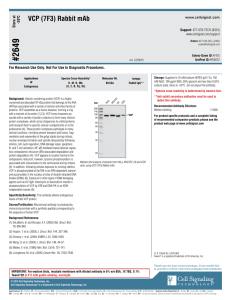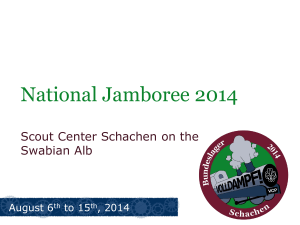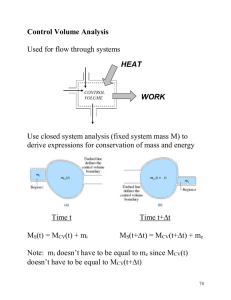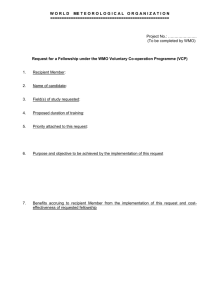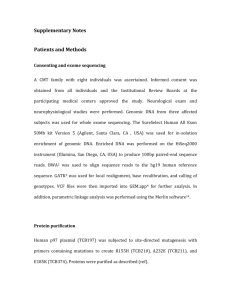Massachusetts Institute of Technology Subject 6.651J/8.613J/22.611J R. Parker
advertisement
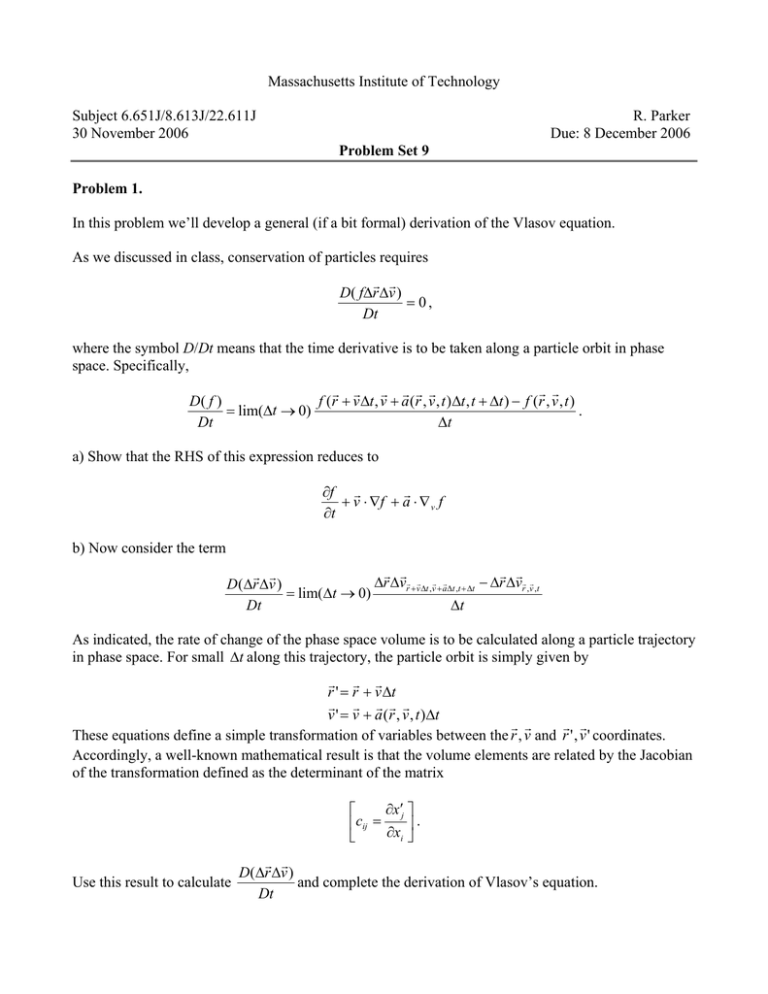
Massachusetts Institute of Technology Subject 6.651J/8.613J/22.611J 30 November 2006 R. Parker Due: 8 December 2006 Problem Set 9 Problem 1. In this problem we’ll develop a general (if a bit formal) derivation of the Vlasov equation. As we discussed in class, conservation of particles requires r r D( fΔr Δv ) = 0, Dt where the symbol D/Dt means that the time derivative is to be taken along a particle orbit in phase space. Specifically, r r r r r r r r D( f ) f (r + v Δt , v + a (r , v , t )Δt , t + Δt ) − f (r , v , t ) = lim(Δt → 0) . Dt Δt a) Show that the RHS of this expression reduces to r ∂f r + v ⋅ ∇f + a ⋅ ∇ v f ∂t b) Now consider the term r r r r r r Δr Δvrr + vrΔt ,vr + arΔt ,t + Δt − Δr Δvrr ,vr ,t D (Δr Δv ) = lim(Δt → 0) Δt Dt As indicated, the rate of change of the phase space volume is to be calculated along a particle trajectory in phase space. For small Δt along this trajectory, the particle orbit is simply given by r r r r ' = r + v Δt r r r r r v ' = v + a (r , v , t )Δt r r r r These equations define a simple transformation of variables between the r , v and r ' , v ' coordinates. Accordingly, a well-known mathematical result is that the volume elements are related by the Jacobian of the transformation defined as the determinant of the matrix ∂x′j ⎤ ⎡ ⎢cij = ⎥. ∂xi ⎦ ⎣ r r D(Δr Δv ) and complete the derivation of Vlasov’s equation. Use this result to calculate Dt Problem 2. In deriving the fluid energy equation in class, we got to the following point: r r m r 2 r t r⎞ r 3 5 ∂ ⎛1 ⎛1 ⎞ 2 2r ⎜ mnu + nkT ⎟ + ∇ ⋅ ⎜ mnu u + nkTu + Π ⋅ u ⎟ + ∇ ⋅ q − qE ⋅ nu = ∫ dv v ∑ C ( f , f β ) . 2 2 2 ∂t ⎝ 2 ⎠ ⎝2 ⎠ β It was then stated that this equation could be transformed into the simpler form: r r ∂u 3 d kT n + p∇ ⋅ u = −Π ij i − ∇ ⋅ q + Q , 2 dt ∂x j where the summation convention applies and Q= m r 2 dww ∑ C ( f , f β ) . 2∫ β Show that the second form follows from the first by using the continuity equation, the result of dotting r the momentum equation with u , and the identity t t r r ∂u − u ⋅ (∇ ⋅ Π ) + ∇ ⋅ (Π ⋅ u ) = Π ij i . ∂x j Problem 3. Consider 1-D plasma oscillations proportional to exp(−iωt + ikx) in a hot plasma with a 1-D electron distribution function given by ~ v f e (v x ) = e 1 . π v + ve2 2 x For simplicity assume that k is real, but that ω could be complex. a) Determine an algebraic dispersion relation for electron oscillations, assuming that the ions are immobile. b) Solve the dispersion relation obtained in a) for ω (k ). c) Now assume that the ions have a distribution function given by ~ v f i (v x ) = i 1 , π v + vi2 2 x while the electron distribution function is the same as in part a). Assuming ω / k << ve , determine ω (k ) for ion acoustic waves. Possibly useful integrals: ∞ vx 1 π ⎧ (ς − ive ) 2 ⎫ dv = − ∫ (vx2 + ve2 ) 2 vx − ς x 2ve ⎨⎩ (ς 2 + ve2 ) 2 ⎬⎭ Im ς > 0 −∞ ∞ v 1 π ∫−∞ (vx2 +xve2 ) 2 vx − ς dvx = − 2ve ∞ ∫ (v −∞ 2 x ⎧ ( v + iς ) ⎫ vx 1 Im ς > 0 dv x = π ⎨ 2e 2 2 ⎬ + ve ) v x − ς ⎩ (ve + ς ) ⎭ 2 x ⎧ ( v − iς ) ⎫ vx 1 Im ς < 0 dv x = π ⎨ 2e 2 2 ⎬ + ve ) v x − ς ⎩ (ve + ς ) ⎭ ∞ ∫ (v −∞ ⎧ (ς + ive ) 2 ⎫ Im ς < 0 ⎨ 2 2 2⎬ ⎩ (ς + ve ) ⎭ ∞ v x2 1 π ⎧ (ς − ive ) 2 ⎫ dv = − ∫ (vx2 + ve2 ) 2 vx − ς x 2ve ς ⎨⎩ (ς 2 + ve2 ) 2 ⎬⎭ Im ς > 0 −∞ ∞ v x2 1 π ⎧ (ς + ive ) 2 ⎫ dv = − ∫ (vx2 + ve2 ) 2 vx − ς x 2ve ς ⎨⎩ (ς 2 + ve2 ) 2 ⎬⎭ Im ς < 0 −∞
